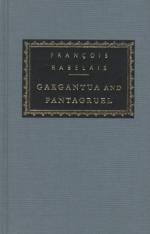In the middle of the roof was fixed a ring of massive gold, as thick as my clenched fist. Three chains somewhat less, most curiously wrought, hung about two feet and a half below it, and in a triangle supported a round plate of fine gold whose diameter or breadth did not exceed two cubits and half a span. There were four holes in it, in each of which an empty ball was fastened, hollow within, and open o’ top, like a little lamp; its circumference about two hands’ breadth. Each ball was of precious stone; one an amethyst, another an African carbuncle, the third an opal, and the fourth an anthracites. They were full of burning water five times distilled in a serpentine limbec, and inconsumptible, like the oil formerly put into Pallas’ golden lamp at Acropolis of Athens by Callimachus. In each of them was a flaming wick, partly of asbestine flax, as of old in the temple of Jupiter Ammon, such as those which Cleombrotus, a most studious philosopher, saw, and partly of Carpasian flax (Ozell’s correction. Motteux reads, ’which Cleombrotus, a most studious philosopher, and Pandelinus of Carpasium had, which were,’ &c.), which were rather renewed than consumed by the fire.
About two foot and a half below that gold plate, the three chains were fastened to three handles that were fixed to a large round lamp of most pure crystal, whose diameter was a cubit and a half, and opened about two hands’ breadths o’ top; by which open place a vessel of the same crystal, shaped somewhat like the lower part of a gourd-like limbec, or an urinal, was put at the bottom of the great lamp, with such a quantity of the afore-mentioned burning water, that the flame of the asbestine wick reached the centre of the great lamp. This made all its spherical body seem to burn and be in a flame, because the fire was just at the centre and middle point, so that it was not more easy to fix the eye on it than on the disc of the sun, the matter being wonderfully bright and shining, and the work most transparent and dazzling by the reflection of the various colours of the precious stones whereof the four small lamps above the main lamp were made, and their lustre was still variously glittering all over the temple. Then this wandering light being darted on the polished marble and agate with which all the inside of the temple was pargetted, our eyes were entertained with a sight of all the admirable colours which the rainbow can boast when the sun darts his fiery rays on some dropping clouds.
The design of the lamp was admirable in itself, but, in my opinion, what added much to the beauty of the whole, was that round the body of the crystal lamp there was carved in cataglyphic work a lively and pleasant battle of naked boys, mounted on little hobby-horses, with little whirligig lances and shields that seemed made of vine-branches with grapes on them; their postures generally were very different, and their childish strife and motions were so ingeniously expressed that art equalled nature in every proportion and action. Neither did this seem engraved, but rather hewed out and embossed in relief, or at least like grotesque, which, by the artist’s skill, has the appearance of the roundness of the object it represents. This was partly the effect of the various and most charming light, which, flowing out of the lamp, filled the carved places with its glorious rays.




